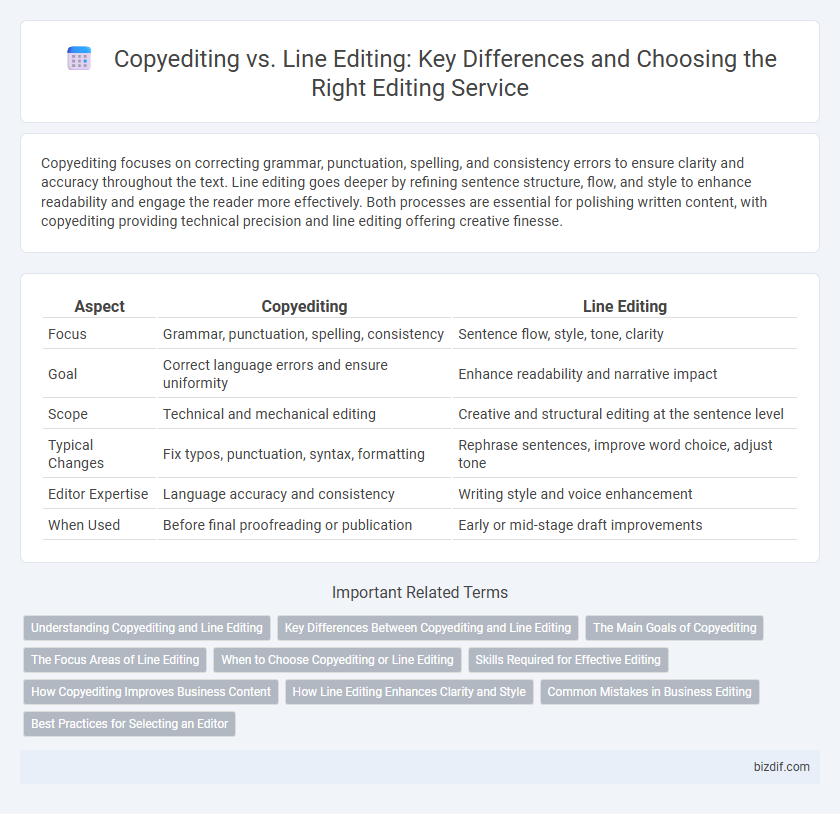Copyediting focuses on correcting grammar, punctuation, spelling, and consistency errors to ensure clarity and accuracy throughout the text. Line editing goes deeper by refining sentence structure, flow, and style to enhance readability and engage the reader more effectively. Both processes are essential for polishing written content, with copyediting providing technical precision and line editing offering creative finesse.
Table of Comparison
| Aspect | Copyediting | Line Editing |
|---|---|---|
| Focus | Grammar, punctuation, spelling, consistency | Sentence flow, style, tone, clarity |
| Goal | Correct language errors and ensure uniformity | Enhance readability and narrative impact |
| Scope | Technical and mechanical editing | Creative and structural editing at the sentence level |
| Typical Changes | Fix typos, punctuation, syntax, formatting | Rephrase sentences, improve word choice, adjust tone |
| Editor Expertise | Language accuracy and consistency | Writing style and voice enhancement |
| When Used | Before final proofreading or publication | Early or mid-stage draft improvements |
Understanding Copyediting and Line Editing
Copyediting involves reviewing a text for grammar, punctuation, spelling, consistency, and accuracy to ensure clarity and correctness. Line editing focuses on the style, tone, flow, and readability of sentences, improving word choice and sentence structure to enhance the overall narrative. Understanding the distinct roles of copyediting and line editing is essential for producing polished, professional writing.
Key Differences Between Copyediting and Line Editing
Copyediting focuses on correcting grammar, punctuation, spelling, and consistency to ensure the text adheres to language rules and style guides, while line editing involves refining sentence structure, flow, and clarity to enhance readability and tone. Copyeditors primarily address technical accuracy, whereas line editors engage more deeply with the author's voice and narrative style. Understanding these distinctions helps writers choose the right type of editing to improve their manuscript effectively.
The Main Goals of Copyediting
Copyediting focuses on correcting grammar, spelling, punctuation, and consistency errors to ensure clarity and professionalism in the text. It also involves checking style adherence, formatting accuracy, and eliminating redundancies to enhance readability. The main goals of copyediting are to produce a polished manuscript ready for publication and maintain the author's voice while improving overall coherence.
The Focus Areas of Line Editing
Line editing concentrates on refining sentence structure, flow, and readability by enhancing word choice, tone, and rhythm to ensure the text's voice and style align with the author's intent. This process addresses clarity, consistency, and the emotional impact of each line, going beyond mere grammar corrections typical of copyediting. Key focus areas include improving dialogue, pacing, and narrative coherence to elevate the overall reader experience.
When to Choose Copyediting or Line Editing
Copyediting is ideal when focusing on grammar, punctuation, spelling, and consistency across a manuscript, ensuring technical accuracy and readability. Line editing is preferable when enhancing sentence structure, flow, and style to improve clarity and tone, especially in narrative or creative writing. Choose copyediting for mechanical polish and line editing for refining prose and narrative nuances.
Skills Required for Effective Editing
Effective copyediting demands strong grammar skills, attention to detail, and the ability to ensure consistency in punctuation, spelling, and formatting. Line editing requires a deeper understanding of narrative flow, tone, and style, with skills in sentence structure, word choice, and enhancing readability without altering the author's voice. Mastery in both areas involves a combination of linguistic precision and a keen editorial eye to improve clarity and coherence in the manuscript.
How Copyediting Improves Business Content
Copyediting improves business content by enhancing clarity, consistency, and grammatical accuracy, ensuring professional communication that strengthens brand credibility. It refines syntax, corrects punctuation, and eliminates errors to create polished documents that engage target audiences effectively. By maintaining style uniformity and factual accuracy, copyediting boosts reader trust and optimizes content for business growth.
How Line Editing Enhances Clarity and Style
Line editing enhances clarity and style by focusing on sentence structure, word choice, and flow to ensure the text reads smoothly and engages the reader effectively. It refines tone and voice while eliminating awkward phrasing, improving overall readability and emotional impact. Unlike copyediting, line editing delves deeper into the narrative rhythm and stylistic consistency, making prose more compelling and polished.
Common Mistakes in Business Editing
Common mistakes in business editing often arise from confusing copyediting with line editing, leading to inconsistent tone and overlooked grammar errors. Copyediting focuses on correcting spelling, punctuation, and syntax to ensure clarity and accuracy, while line editing refines sentence structure and flow for readability and impact. Neglecting the distinct goals of each editing type can result in content that is technically correct but lacks engagement or precision essential for professional business communication.
Best Practices for Selecting an Editor
Copyediting targets grammar, punctuation, and consistency, ensuring clarity and correctness, while line editing emphasizes style, tone, and flow to enhance reader engagement. Best practices for selecting an editor involve assessing the manuscript's current needs and project goals, matching those with the editor's expertise and experience in the specific editing type. Evaluating sample edits and seeking recommendations from trusted author communities ensure alignment with the desired editing level and quality.
Copyediting vs Line Editing Infographic

 bizdif.com
bizdif.com